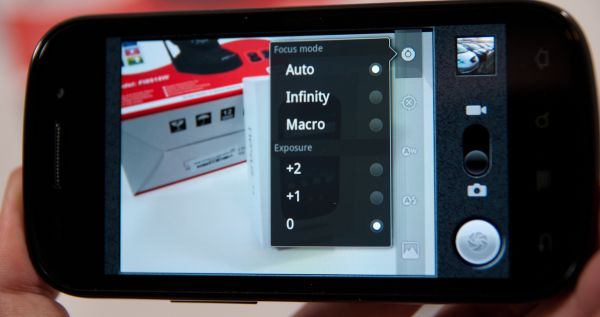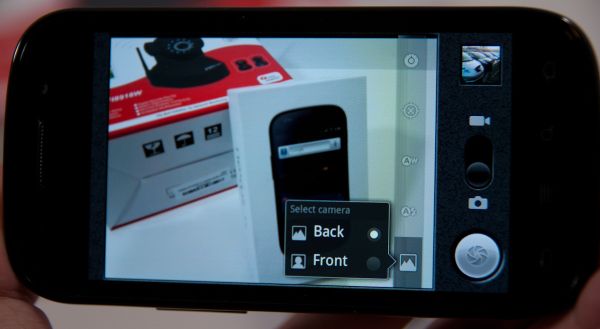Nexus S and Android 2.3 Review: Gingerbread for the Holidays
by Brian Klug on December 14, 2010 4:08 PM EST- Posted in
- Smartphones
- Samsung
- Nexus S
- Gingerbread
- Android 2.3
- Mobile
Camera Analysis
If there’s anything to be learned in a straight comparison between the Nexus One and Nexus S, it’s again that megapixels don’t matter. I never was a huge fan of the Nexus One camera - there’s a strange undersaturation in some images, and that extra glare from having another layer of plastic between the lens and your object where grime could collect.
The Nexus S is overall much improved, but still not perfect. Again, the obvious analogue here is to the Galaxy S, but side by side quality on the Fascinate looks markedly superior in our lights-on test. With the lights off and the flash set to auto, the Nexus S is much improved. The reason is that the stock camera now correctly illuminates the object while running the autofocus routine - the result is that in the dark shots are now focused properly. Further, you get an idea for whether the flash reaches far enough to actually do any good. Kudos to Google for fixing this.
Even more Kudos, however, for adding some manual focus settings. Tap on the settings button, and you can select from Auto, Infinity, and Macro. Objects beyond hyperfocal distance are essentially in focus when the camera is focused to infinity, so if you’re shooting photos beyond a certain distance and don’t want to bother with wasting time focusing, infinity is super useful. Likewise, macro gets you the closest possible focus.
The back facing camera isn’t the best we’ve seen, but it’s an improvement from the Nexus One. In our lightbox test, there’s still a lot of missing dynamic range and detail in the texture on the Exacta camera, but there’s so much more contrast compared to the Nexus One.
I took photos in our bench location, in the light box with lights on and off, and then just casually while I carried it around.
There’s also a button along the row of other camera settings buttons for changing to the front facing camera. When you’re in the front facing camera, a few options go away. You can’t change resolution, and focus controls are also obviously gone since the camera is fixed focus. Resolution is VGA. Quality on the front facing camera isn’t spectacular, but then again the aperture diameter on that camera is barely 1 mm. The front facing camera also flips-images horizontally after capture.
What’s odd about the Nexus S is that video encoding is only 720x480, not the HD 720P we’re used to seeing with the Galaxy S. Video is encoded in H.264 with AAC audio, at an average bitrate of 3,664 kilobits/s on the back camera. The front camera records at 640x480 with the same codecs at just over 1 megabit/s.
I noticed that audio doesn’t quite sync up in the front facing camera video, which is a bit unnerving to say the least. The back camera is fine, and seems relatively smooth. Not having 720P is a disappointment, hopefully someone unlocks HD recording on the Nexus S same as was done on the Nexus One. It certainly isn’t a matter of the SoC not being powerful enough if Galaxy S can do it.
I took a video with the front and back facing camera at our usual location:
Rear Camera:
Front Camera:
And one more video in a different location per some commenters asking for an indoor to outdoor progression for gauging quality.





































73 Comments
View All Comments
Zingam - Thursday, December 16, 2010 - link
I agree I have a nokia and the phone jack is on the top side. I have wished many times that it is on the bottomcece74 - Thursday, December 16, 2010 - link
I also miss the trackball on my Galaxy S.But I now use Swiftkey , a pretty good keyboard, and it also have arrow keys (press "123" then symbols : {&= key) to see it.
JimmiG - Thursday, December 16, 2010 - link
Basically a Galaxy S (which was basically a Nexus One with a better screen and faster GPU), with a few extra features, unlike the Nexus One which was pretty revolutionary for its time.Of course, the Nexus One isn't even a year old, which isn't such a long time.. but sometimes it feels like the N1 was released in another decade considering how fast things have moved. I hope the Nexus 3 or whatever at least as a dual-core out-of-order CPU and other improvements.
blueF - Thursday, December 16, 2010 - link
Well I purchased my Nexus S, and am very pleased with the phone. Scrolling is not as smooth as I was lead to believe, but still glad I purchased one.bobshute - Thursday, December 16, 2010 - link
Brian, are you sure on the 3G radio.The T-mobile Samsung Vibrant radio, although not advertised, is at least Quad band
It has the 1900 radio on by default for 3G on AT&T.
You can also turn on the 850 band in the service menu although it's not confirmed to work in 850 mhz only areas of AT&T coverage.
Voldenuit - Friday, December 17, 2010 - link
>Don't you usually have your phone in your pocket upside down anyway?Not if it's in the shirt pocket. Or jacket inner pocket. Or on a belt holster.
I'm a lot more likely to use a headphone with the phone in these places rather than in my pants pockets, where walking, sitting or standing up is more liable to crush/damage the headphone jack.
Inuit - Saturday, December 18, 2010 - link
A new on-screen keyboard for Android from Keypurr has directional keys, and it is in the main screen (no need to flip to another screen). I am using Keypurr on my Galaxy S - and love it!In addition, it has large keys (almost twice as large as the standard keyboard) and very clever and up-to-date dictionary. I can type on it as fast as hardware keyboard, or type one handed. It also comes in black or white skins, has function keys, and more. I think Keypurr has some good short videos on their site: www.keypurr.com
keypurrtech - Sunday, December 19, 2010 - link
Keypurr is a new Android keyboard that uses a full QWERTY layout with keys that are are almost twice the size of other onscreen QWERTY keyboards. It also has a dictionary that includes abbreviations, acronyms, and words borrowed from other languages. Best of all for Nexus S users (and anyone who's phone doesn't have a trackpad) it includes customizable function keys that can be used as directional controls.Keypurr allows users to type with greater speed, confidence, and ease, than any Android keyboard! Check out our website: www.keypurr.com or our youtube channel: www.youtube.com/keypurrtech to learn more.
teohhanhui - Monday, December 20, 2010 - link
"... people want carriers to provide first-party support for devices, and people want to play with devices in stores before making the jump ..."I wouldn't consider a carrier as the first party when it comes to providing support for phones (there is no doubt that they are the first party when it comes to network issues). As it stands, carriers are only worsening the experience by slapping on unwanted customizations and hindering roll-outs of OS updates.
What is stopping you from "playing with devices" in a retail store (either by manufacturer/OS vendor/authorized reseller)?
IMO the real reason for the prevalence of "carrier subsidies" seems to be consumers preferring to pay by installment, or simply unaware of the fact that they end up paying more in the end.
ravenfq - Tuesday, December 21, 2010 - link
I'm always disappointed to find that no reviewers mention the fact that Android doesn't support WiFi proxy 'out of the box' - any suggested solutions to this lack of functionality require that the user 'root' their device, which is not necessarily acceptable to everyone (for all sorts of reasons).This lack of functionality precludes student usage on campus, and crucially (in my opinion) any corporate in-house 'managed' usage, where any WiFI authentication is a pre-requisite.
As a CIO, I'm forced to eliminate Android-based devices from consideration as a corporate standard, and constrain my options to Apple, Microsoft and (hopefully) any upcoming HP WebOS-based devices.
This is deeply disappointing to me personally, as I applaud any attempt to separate the OS from the hardware, liberating hardware manufacturers to compete and innovate, and thus giving us, the end users, ever expanding and increasing capabilities in a portable device. I had high hopes for the relatively open Android environment in this regard.
I would also refer you to this (somewhat emotive) link that outlines the issue in more detail:
http://code.google.com/p/android/issues/detail?id=...
Thank you, Anandtech, for what is otherwise superb technical journalism.